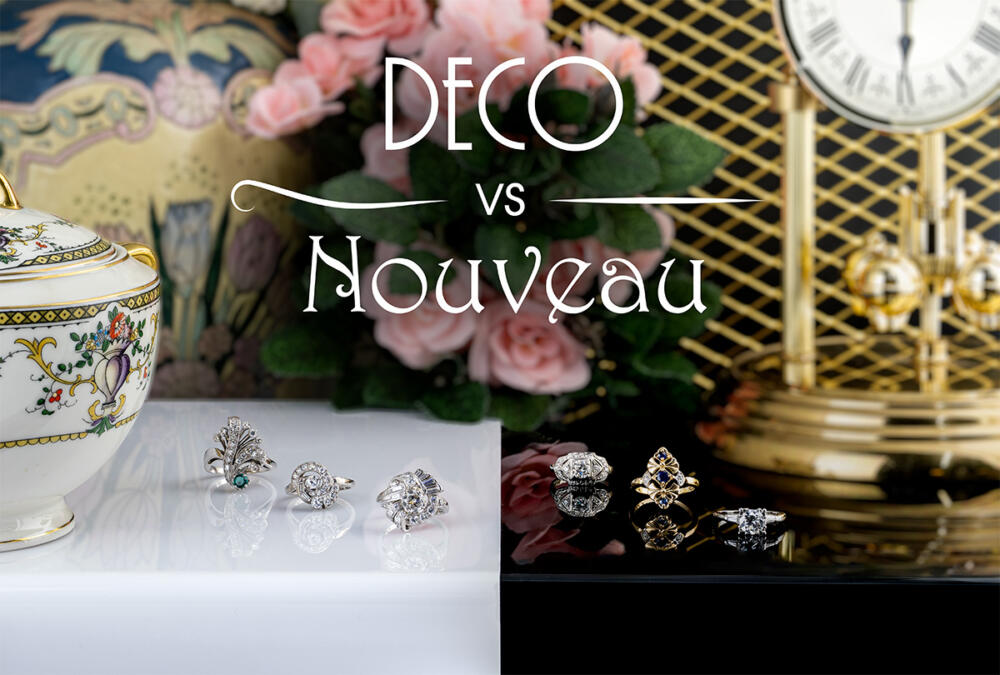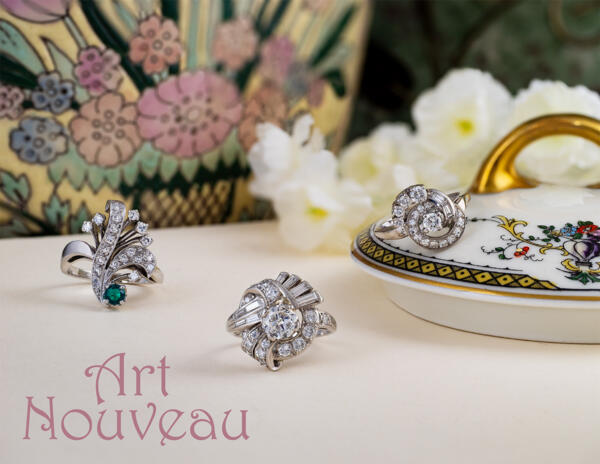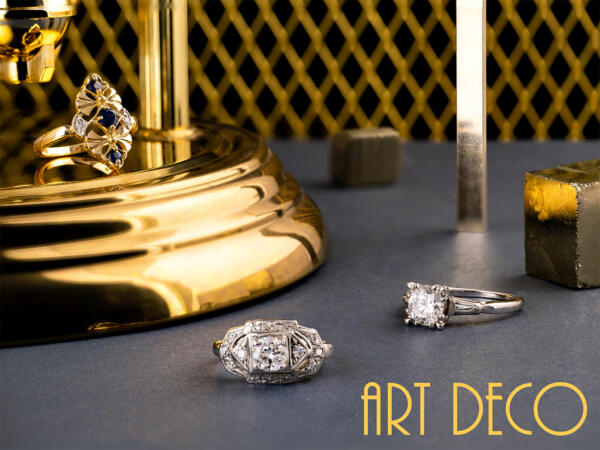Art Deco vs. Art Nouveau Style Jewelry
What are the key differences between these two iconic movements?
We also have a fun, informative video on Art Deco vs. Art Nouveau jewelry which you may like.
The Art Nouveau and Art Deco movements have had a profound impact on virtually all forms of art and design, including jewelry, for over 100 years. Each style brought unique elements into jewelry design, reflecting broader cultural and artistic shifts while captivating wearers with their unmistakable aesthetics.
While there is always overlap in art, these two particular movements formed around very distinctive ideas which led to very different expressions in jewelry. Once you learn about the fundamental styles of each, you will start to see their influence everywhere. They are also important guide posts that can aid in dating vintage and antique jewelry. So, what are these two movements all about, and where did they come from?
Origins and Historical Context
Originating in the late 19th century (1890 – 1910), Art Nouveau emerged as a rebellion against the academic art of the time. It sought to bring the natural world into artistic design, emphasizing flowing lines, asymmetrical forms, and motifs inspired by plants, flowers, and the human form. Art Nouveau, also referred to as Jugendstil and Stile Liberty among many other monikers, simply means “New Art” and it impacted almost every artistic medium. Jewelry makers embraced materials such as enamel, horn, and semi-precious stones to create pieces that were not just adornments but works of art. Many Art Nouveau jewelry pieces were made in silver, but white gold and platinum were quite common as well. The diamonds used in Art Nouveau jewelry were typically Old Mine cuts, but Old European cut stones were also included as they became more popular.
In contrast, Art Deco arrived in the 1920’s and 1930’s, characterized by its celebration of modernity, geometric shapes, and luxurious materials. The opulence and optimism of The Roaring 20’s formed the perfect backdrop for this new kind of art to emerge. Art Deco jewelry design embraced symmetry, bold colors, and streamlined forms influenced by Cubism and the Machine Age. Precious metals like platinum and white gold alongside rare and valuable gemstones such as diamonds, emeralds, and sapphires, were the materials of choice for Art Deco jewelry makers. The most prevalent diamond cut found in Art Deco jewelry is the Old European cut, but some pieces still incorporated Old Mine cuts or transitional cuts.
Design Principles
Art Nouveau takes inspiration from nature and eschews rigid adherence to symmetry and balance.
- Organic Forms: Art Nouveau jewelry features sinuous, curving lines that mimic natural shapes such as vines, flowers, and insects. Asymmetry is very common.
- Symbolism: Often imbued with symbolism and allegory, Art Nouveau jewelry intends to evoke emotions and narratives through its designs.
- Craftsmanship: Art Nouveau artisans prioritized craftsmanship and detail, often incorporating techniques like enameling, plique-à-jour (stained glass inspired enameling), and intricate metalwork.
Art Deco, on the other hand, stands in stark contrast to the unruly, free-form expression of its predecessor.
- Geometric Precision: Art Deco jewelry is characterized by sharp lines, geometric shapes (such as triangles, rectangles, and circles), and symmetrical patterns.
- Bold Colors and Contrasts: Contrasting colors and materials create striking visual effects in Art Deco designs, emphasizing symmetry and balance.
- Innovation in Materials: Art Deco designers embraced new materials like Bakelite, celluloid, and chrome alongside traditional precious metals and gemstones to create dynamic and futuristic designs.
Influence and Legacy
Although it was relatively short-lived, Art Nouveau continues to inspire contemporary jewelry designers with its emphasis on natural beauty, asymmetry, and innovative use of materials. Art Nouveau jewelry remains highly sought after by collectors for its rarity, craftsmanship, and artistic merit. Here in America, Louis Comfort Tiffany, was one of the most well-known practitioners of the Art Nouveau style. His jewelry and glass work are quintessential pieces in the Art Nouveau canon.
Art Deco jewelry’s popularity has endured over the decades, with periodic revivals in fashion and design occurring regularly. The most recent of which surrounded the 2013 release of The Great Gatsby which was itself an ode to the time and style of Art Deco. Modern jewelry design continues to be influenced by Art Deco trends, particularly in its use of geometric shapes and luxurious materials. World famous designers like Cartier and Van Cleef & Arpels are known for their contributions to the Art Deco movement among many others.
Quick Comparison
Here is a quick chart to help break down the key difference between Art Nouveau and Art Deco jewelry design.
| Art Nouveau | Art Deco | |
|---|---|---|
| Time Period | 1890-1910 | 1920-1930 |
| Key Aesthetic | Organic, flowing lines, nature | Geometric symmetry, bold contrast, simplicity |
| Materials of Choice | Silver, semi-precious stones, enamel | Platinum, diamonds, emeralds |
| Prominent Designers | Louis Comfort Tiffany | Cartier, Van Cleef & Arpels |
| Main Diamond Cut | Old Mine Cut | Old European Cut |
Final Words
Art Nouveau and Art Deco represent two distinct and highly influential styles in the history of jewelry design. Art Nouveau jewelry celebrates nature’s beauty with flowing forms and intricate details, and Art Deco jewelry epitomizes the modern era’s sophistication and geometric precision.
Both styles have left an indelible mark on the world of jewelry, continuing to inspire designers and collectors alike with their timeless elegance and innovative craftsmanship. Whether you’re drawn to the organic allure of Art Nouveau or the bold symmetry of Art Deco, we at Arden Jewelers would love to help you find the perfect piece for you.
We have our own collection of authentic Art Nouveau and Art Deco pieces as well as access to a full network of vintage and antique jewelry. Or, if you are looking for a new piece inspired by one of these two styles, our talented jewelry designers would love craft an original piece just for you. Reach out to us anytime.


